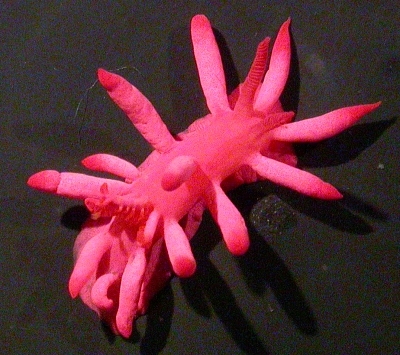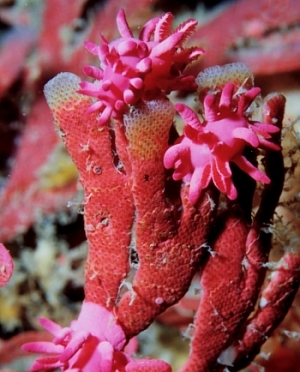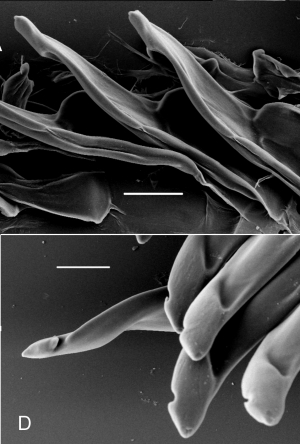
Okenia atkinsonorum
Rudman, 2007
Order: NUDIBRANCHIA
Suborder: DORIDINA
Superfamily: ANADORIDOIDEA
Family: Goniodorididae
DISTRIBUTION
Known at present from New South Wales, southeastern Australia and probably nthn New Zealand [see message #21216 ]
PHOTO
The Pipeline, west side of Nelson Bay, Port Stephens, New South Wales, Australia, on Pleurotoichus clathratus, 11 m, 11 June 2005, 13-15 mm long alive. AM C 445669. Upper: Photo: Des Beechey. Lower left: feeding on on Pleurotoichus clathratus. Photo: L. & D. Atkinson. Lower right: radula teeth. Photo: Alison Miller.
The animal is bright pink except for tips of the mantle processes, gills and rhinophores, which are a deeper, redder shade of the same colour. The body has a relatively low profile and lacks a mantle ridge, but its position is indicated by up to seven large mantle papillae on each side. The lateral pap In body shape, O. hallucigenia differs from the other two species in its elongate and high body profile and the distinct and separate oral veil.illae are usually arranged in pairs opposite one another, but there can be one or two extra, and unmatching, on either side. Some papillae are bluntly rounded, while others have a pointed tip. There are usually two dorsal mantle papillae, in the midline, one in front of gills, one behind. There are usually five gills arranged in an arc around the anal papilla, each gill inserted separately. From above the head is indistinguishable from the foot but ventrally there is a distinct V-shaped groove differentiating the head and the foot.
The radular teeth of O. atkinsorum have some similarities to those of O. stellata in having a long elongate first lateral tooth but the teeth differ in shape and size. In O. stellata these teeth are simple rod-like structures, 800 microns in length, with a groove along one edge, while in O. atkinsonorum the teeth have a wide base, and taper to a tip which bears a subapical harpoon-like flange. Although more elongate than the teeth of most species of Okenia, they are only about 300 microns in length, so much shorter than those of O. stellata. In colour, O. atkinsonorum and O. hallucigenia are very similar, being a uniform pink except for the tips of the dorsal tentacles, papillae and rhinophores, which are a deeper reddish pink. Neither species have the red lines which form part of the colour pattern of O. stellata.
O. hallucigenia differs from the other two species in its body shape, and the shape and small size of its radula teeth. All three species feed on the bryozoan Pleurotoichus clathratus. This species is named after Leanne & David Atkinson who have observed this animal in the Port Stephens region, from the west side of Nelson Bay to Halifax Park, for over 15 years. They are regular contributors to the Forum and have made many valuable contributions to my research.
Note: This species has been misidentified by me as O. hallucigenia in earlier messages to the Forum.
- Rudman, W.B. (2007) Two new species of Okenia (Gastropoda: Nudibranchia: Goniodorididae) from eastern Australia and Tanzania. Zootaxa, 1657: 57–67.


Rudman, W.B., 2007 (December 10) Okenia atkinsonorum Rudman, 2007. [In] Sea Slug Forum. Australian Museum, Sydney. Available from http://www.seaslugforum.net/factsheet/okenatki
Related messages
-
Re: Okenia atkinsonorum - another pink species
From: Leanne & David Atkinson, January 31, 2008 -
Okenia atkinsonorum? from New Zealand
From: Ian Skipworth, December 10, 2007 -
More photos of Okenia atkinsonorum
From: Bill Rudman, December 10, 2007 -
Okenia atkinsonorum - another pink species
From: Bill Rudman, December 10, 2007 -
Okenia hallucigenia from Bare Island, Sydney
From: R. Fea & J. Coombs, May 9, 2005 -
Re: Okenia cf. hiroi from New Zealand
From: Ian Skipworth, January 26, 2005 -
Okenia hiroi? from New Zealand
From: Ian Skipworth, January 25, 2005 -
Hopkinsia sp. laying eggs
From: Leanne Atkinson, March 4, 2003 -
Hopkinsia from Sydney
From: Allan Saben, February 8, 2003 -
Observations on Hopkinsia sp.
From: David Atkinson, January 29, 1999 -
Totally pink!
From: Bill Chambers, January 13, 1998
